Google How to Get Black Spots Off of Apples
Apple (Malus)
Plant Health Problems
Diseases caused by Fungi:
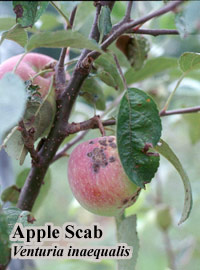 Scab, Venturia inaequalis.
Scab, Venturia inaequalis.
This disease is caused by a fungus. It appears as circular, olive-black spots on the leaves, fruit, and young fruit stems. Heavy infection will cause dropping of young fruits, distortion and cracking of growing fruit, as well as extensive defoliation. The fungus overwinters on the fallen infected leaves, producing a spore stage in the spring that infects the young leaves and fruit during periods of rain. Infection can take place, with suitable weather conditions, at any time after growth starts until the middle of June. During the summer a different spore form is produced, on the leaves and fruit, which continues to produce new infections when washed onto leaves and fruits by rains. During heavy fall rains these summer spores may cause late fruit infections that can develop in storage as typical scab spots, or rarely as small black lesions without the usual production of spores.
Apple scab is most effectively controlled by planting resistant varieties such as Liberty, Jonafree, Priscilla, and Redfree. New scab-resistant varieties are continually under development and testing. In the case of susceptible varieties such as McIntosh or Cortland, control is concentrated on preventing scab from becoming started in the spring. The disease overwinters on diseased leaves on the ground. Therefore, control measures should begin with the removal of the overwintering leaves from beneath the tree and in the surrounding area before budbreak. Control can also be achieved with the use of fungicide sprays. Among the compounds registered for use in Connecticut are captan, fenarimol, ferbam, maneb, thiophanate-methyl, and sulfur. Consult the label for dosage rates and safety precautions. Adequate control can usually be achieved with a general purpose tree fruit spray containing captan. Generally, protection must be given the trees from budbreak until well into the growing season, usually two weeks or more after petal fall. Proper timing and thoroughness of the spraying are essential for control. For more information, see the fact sheet on Disease Control for the Home Apple Orchard.
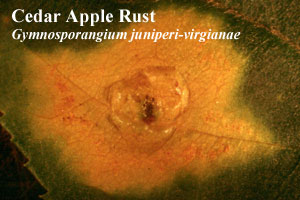
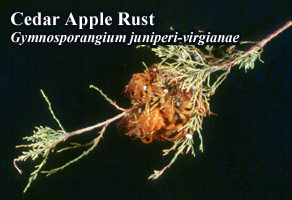
Cedar-apple rust, Gymnosporangium juniperi-virginianae.
The fungus causing this disease is a heteroecious rust having one stage of its life cycle on the apple and the other on red cedar. From this dual existence, the disease derives its common name, cedar-apple rust. The fungus causes fleshy galls on the cedar on which are produced bright orange gelatinous horns during rainy periods. On these horns are produced spores which are blown by the wind to apple trees, there causing bright orange spots on the foliage and to a lesser degree on fruit. The infections on apple foliage produce another spore stage, borne in delicate cup-like structures, which re-infect the cedar and thus the cycle is complete. A related fungus, quince rust, Gymnosporangium clavipes, infects the fruit of Cortland and McIntosh, although they are resistant to cedar-apple rust.
Removal of red cedars near apple trees can help reduce the disease, although this is not usually practical. Rust is most effectively controlled by planting resistant varieties such as Delicious, Empire, Jonamac, McIntosh, and Paula Red. Control can also be achieved with the use of fungicide sprays. Among the compounds registered for use in Connecticut are fenarimol, ferbam, maneb, thiram, and triadimefon. Consult the label for dosage rates and safety precautions. For more information, see the fact sheet on Cedar-Apple Rust.
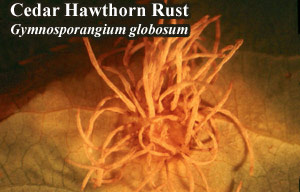 Cedar-hawthorn rust, Gymnosporangium globosum.
Cedar-hawthorn rust, Gymnosporangium globosum.
The rust spots appear brown or orange-yellow on the upper side of the leaves, but from the underside long slender whitish tubes break open to shed orange-brown spores. Infected leaves fall prematurely. The alternate host is red cedar or juniper species. The disease cycle and control strategies are essentially the same as for cedar-apple rust. See Hawthorn for a more detailed discussion of this disease.
Powdery mildew, Podosphaera leucotricha.
This fungus produces a superficial, white powdery growth on the foliage and immature twig growth of apple. In severe cases the leaves and young stems are stunted and distorted. The causal fungus overwinters in the vegetative stage under the bud scales and on the twigs. The fungus starts growth when the buds start, but as it requires high temperatures and a minimum of moisture for optimum growth, it does not become apparent until the hot dry summer weather. Powdery mildew is not usually a problem in Connecticut orchards.
The impact of the disease can be lessened by pruning to remove infected terminals and to improve air circulation. The varieties Freedom, Jonafree, Liberty, and Priscilla are resistant to this disease. When it is a problem, control can be achieved with the use of fungicide sprays during the prepink and pink apple flower bud stages. Among the compounds registered for use in Connecticut is sulfur. Consult the label for dosage rates and safety precautions.
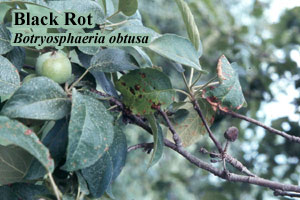 Black rot, Botryosphaeria obtusa.
Black rot, Botryosphaeria obtusa.
Black rot appears on the maturing fruit as a hard brown rot on the surface of which appear concentric rings of minute black pustules. This rot eventually involves the entire fruit which then turns coal black and shrivels to a hard mummy. Foliage infection shows as small circular brown spots scattered over the leaf suggesting the common name of "frogeye" leaf spot. Severe infection may cause defoliation. The fungus also causes shallow cankers on the branches. Spores from the mummified apples and the branch cankers are washed by rain onto the foliage in the spring before bloom.
Control begins with the removal of dead and infected branches and of mummified fruit. Control can also be achieved with the use of fungicide sprays. Among the compounds registered for use in Connecticut are captan, ferbam, thiophanate-methyl, and sulfur. Consult the label for dosage rates and safety precautions. Adequate control can usually be achieved with a general purpose tree fruit spray containing captan.
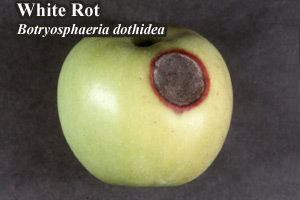 White rot, Botryosphaeria dothidea.
White rot, Botryosphaeria dothidea.
Lesions usually appear on the maturing fruit about one month before harvest and begin as small, slightly sunken brown to tan spots which may be encircled by a reddish halo. As the lesions expand, the rot extends all the way inward to the core. When the disease develops under warm temperatures, the rotted fruit appears clear tan to light brown, and are soft and watery. Rotted fruit usually drop from the tree, however, some can dry down and remain on the tree to serve as a source of inoculum for further infections. Infections on limbs and twigs begin around bark lenticels. When cankers become large, the bark can crack and branches can become girdled. The pathogen survives the winter in cankers on twigs and branches and in mummified fruit.
As with black rot, control measures begin with the removal of dead and infected branches and of mummified fruit. Control can also be achieved with the use of fungicide sprays. Among the compounds registered for use in Connecticut are captan, ferbam, thiophanate-methyl, and sulfur. Consult the label for dosage rates and safety precautions. Adequate control can usually be achieved with a general purpose tree fruit spray containing captan.
Brooks spot, fruit speck, Mycosphaerella pomi.
Small irregular black specks on the skin of the apple fruit, usually on the calyx end, characterize this disease. Infection takes place from June 10 to mid-July but the specking of the fruit may not show until picking time.
Control can be achieved with the use of fungicide sprays. Among the compounds registered for use in Connecticut are captan, ferbam, thiophanate-methyl, and sulfur. Consult the label for dosage rates and safety precautions. Adequate control can usually be achieved with a general purpose tree fruit spray containing captan.
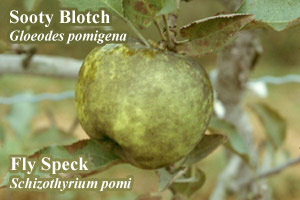 Sooty blotch, Gloeodes pomigena.
Sooty blotch, Gloeodes pomigena.
As the common name suggests, this disease is characterized by circular sooty-black blotches on the skin of the apples. As with fruit speck the infection period is in early summer but the blotches are not evident until near harvest time. The fungus grows entirely on the surface and is, therefore, mainly a cosmetic problem.
Although tenacious, it is possible for the fungus to be washed off the apple. Control can also be achieved with the use of fungicide sprays. Among the compounds registered for use in Connecticut are captan, ferbam, thiophanate-methyl, and sulfur. Consult the label for dosage rates and safety precautions. Adequate control can usually be achieved with a general purpose tree fruit spray containing captan.
Fly speck, Schizothyrium pomi.
As the common name implies, this fungus produces minute black specks that are almost identical to fly specks on apple fruit. These specks are congregated in circular areas on the skin of the fruit. Like sooty blotch it is only a skin blemish, not affecting the flesh at all. Fly speck and sooty blotch typically occur on the same apple; together they are known as summer diseases.
The time of infection and control are the same as for sooty blotch.
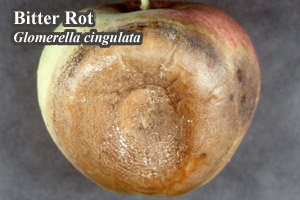 Bitter rot, Glomerella cingulata.
Bitter rot, Glomerella cingulata.
A hard, light brown fruit rot, circular in outline is characteristic of this disease. These rotted areas eventually become black, sunken, and covered with more or less concentric rings of pink, glutinous spore masses. The fungus also causes indistinct cankers on the branches, which serve as reservoirs of inoculum for fruit infection.
This disease is relatively rare in Connecticut and is generally controlled as long as other diseases are controlled.
Brown rot, Monilinia fructicola.
This fungus, most commonly found on stone fruits, may occasionally cause a rot of ripe apples. Early varieties are most commonly affected. See Peach for a more detailed discussion of this disease.
If brown rot does become a problem, control can be achieved with the use of fungicide sprays. Among the compounds registered for use in Connecticut are captan, thiophanate-methyl, and sulfur. Consult the label for dosage rates and safety precautions. Adequate control can usually be achieved with a general purpose tree fruit spray containing captan.
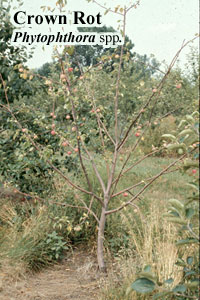 Crown rot, Phytophthora spp.
Crown rot, Phytophthora spp.
This is a soilborne disease of the rootstock portion of the tree that affects bark tissues where the roots meet the stem. Foliar symptoms indicate a general root or vascular disorder and are not diagnostic for the disease. Symptoms on the crown are generally not visible unless the outer layers of bark are removed to expose the cambium layer. Instead of appearing a healthy white, affected tissues will appear orange to reddish-brown. These tissues will eventually turn dark brown as they decay.
Prevention is the best medicine for this disease. Planting trees in heavy, wet soils should be avoided. The disease is generally not a serious problem for trees planted in well-drained soils. Susceptibilities of rootstocks vary, with seedling and M.9 rootstocks generally being resistant.
Diseases caused by Bacteria:
Crown gall,
Agrobacterium tumefaciens.A bacterial disease causing woody galls on the roots and at the crown of the tree. The causal organism probably enters through small wounds caused by handling or by insects or nematodes. This disease is neither common nor important in orchard trees in Connecticut, but it occasionally causes minor injury to nursery stock.
No practical field control has been devised, but important deterrents to this disease are sanitation, good cultural practices, and avoiding the use of susceptible rootstock.
Fire blight, Erwinia amylovora.
This is a bacterial disease that kills the twigs, foliage, and fruit. The wood of the infected twigs is black or dark brown and the bark is darker than normal. The edge of the infected area of bark is slightly sunken and very sharply defined. The most characteristic symptom is shown in the foliage and young fruit which are a black brown and remain firmly attached to the dead twig. Infection occurs on the blossoms and spreads into the fruit spur and immediately adjacent branch. Fortunately, this disease is only an occasional problem in Connecticut.
Planting resistant cultivars such as Liberty, Empire, and Winesap can essentially avoid this problem. Trees on rootstocks MM.111 and M.7 EMLA are generally less susceptible to fire blight. When infections do occur, it is important to prune back to healthy wood during the dormant season, making sure to remove prunings from near the tree. Pruning cuts should be made at least 8 to 12 inches below the visible symptoms, and care should be taken to disinfest tools with 10% household bleach or 70% alcohol. It is important to avoid heavy applications of nitrogen in the spring.
For more information, see the fact sheet on Fire Blight.
Diseases caused by Physiological/Environmental Factors:
Bitter pit.
This trouble is characterized by brown corky flecks in the flesh of the fruit. The flecks are most frequently found just under the skin of the apple but may be scattered through the flesh extending as far as the core. Bitter pit spot differs from drought spot in that the spots are sharply defined whereas drought spot is a solid browning of the affected tissue. The bitter flavor of the corky tissue gives the name bitter pit. This trouble is not caused by an organism. It is thought to be caused by a nutritional imbalance, possibly involving the ratio of calcium to other components of the fruit, coupled with certain moisture and temperature factors. The older varieties Baldwin, Greening, and Northern Spy are the more susceptible varieties; the McIntosh group and more modern varieties are rarely affected.
Bitter pit can be reduced by foliar applications of calcium.
Cork spot.
This condition is another calcium-related disorder and has symptoms very similar to bitter pit. Brownish spots occur in the flesh of the apple and sometimes extend outward to the skin where they appear as brownish-red depressions on the surface of the apple. (See Bitter pit.)
Drought spot, physiological.A physiological trouble due to boron deficiency accentuated by drought conditions. The fruit has brown corky areas in the flesh around the core, which in severe cases extend to the outside causing cracking and distortion. Eventually the new growth fails to develop the side buds, resulting in naked twigs with tufts of foliage at the tips.
Application of borax to the ground around the tree can correct the trouble.
Water core.
This trouble shows as translucent areas in the flesh of the apple, which may be confined to the flesh around the core or may encompass the entire fruit giving it a characteristic glassy look. Fruit affected with water core is heavier and harder than normal apples and the normal flavor is masked by a sweet syrupy flavor. This condition, related to a calcium imbalance, is rarely a problem.
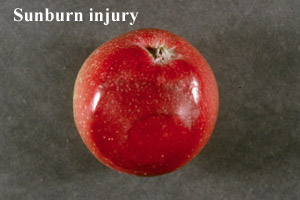 Sun scorch, environmental.
Sun scorch, environmental.
Sun scorch on fruit occurs on the apples on the south side of the tree and on the side exposed to the sun. Air temperatures above 90 F coupled with low humidity are necessary for sun scorch. The injury shows as circular areas varying in color from a pale yellow through buff to brown. In extreme cases the areas are flattened and black with a light halo. Foliage scorch as a direct result of high temperatures is less common and shows as irregular light-brown areas. Sunburn of the bark on large branches frequently results when old trees are heavily pruned and branches, for a long time protected from the direct rays of the sun, are exposed. Obviously this injury is confined to the upper side of the branch. The burning results in varying degrees of injury from a roughening of the bark to a complete killing of large areas. Wood-rotting fungi enter through these dead areas and loss of entire branches may eventually result.
Prolonged winter temperatures below -10 F, environmental.
This can kill the bark and cambium on the lower side of apple branches nearest the ground. Trees that have borne a heavy crop of fruit the preceding summer are most likely to be injured by low temperatures. In both cases the lack of stored carbohydrates in the wood is the controlling factor. There is less carbohydrate storage in the underside of the branch and the tree that had a full crop of apples is low in stored carbohydrates. Late frosts may cause foliage injury and fruit russetting. The effect of frost on young leaves is to stop the growth on the lower side of the leaf causing a downward cupping and a loosening of the lower epidermis, which will be stretched across the cupped leaf like a drum head. Fruit russetting may appear as a random pattern of russet or it may appear as equatorial bands or a random pattern of arcs of circles.
Hail injury, environmental.If severe enough, is immediately apparent and recognizable but a slight bruising may not be evident until picking time. The chief diagnostic character would be the location of the injury on the upper and outer surfaces of the fruit. Like hail injury on the fruit, severe twig injury is at once apparent but slight injury will not show until next year when a series of sunken eye-shaped spots will appear on the upper side of the twigs. These spots will show for several years until entirely covered by new growth.
Spray injury.
With the wide diversity of materials and combinations of materials that may be used as sprays and the equally wide diversity of weather conditions under which they may be applied, it is of little value to try to describe the injuries that might occur. Perhaps all one can say is that all spray injuries have two characteristics in common. They usually appear over a wide area at once and while the injury may increase in severity with time, it does not spread with time to trees or parts of trees originally free of injury.
Insect Problems
Apple-and-thorn skeletonizer, Choreutis pariana.
Caterpillars of this moth skeletonize leaves while they live under a flat web. The caterpillars are pale yellowish green with black spots and a brown head. The moths are brown with a purplish tinge and have a wingspan of 1/2". Skeletonizers have 3 generations a year, but they are seldom abundant enough to justify applying an insecticide.
Apple aphid , Aphis pomi.
Aphids damage leaves on water sprouts and rapidly growing terminal shoots. Young apples may be deformed when infestations are severe. In the fall, females lay elongate shiny, black eggs on the bark. The nymphs hatch from eggs in the spring. Both the nymphs and adults of this small green aphid pierce apple tissue to suck the sap in apple stems, foliage, and fruit. During the growing season, apple aphids have many generations, during which young are produced asexually. In the fall, sexual forms appear, and after mating, the females lay the eggs that will overwinter. Heavy fertilization with nitrates may increase aphid infestations. Materials registered in Connecticut to control aphids on apples include horticultural oil, malathion, diazinon, azadirachtin, ryania, and insecticidal soap. Dormant sprays of horticultural oil have been marginally effective because of later migration. Sprays of malathion and diazinon control aphids but are detrimental to natural enemies. Azadirachtin, ryania, and insecticidal soap are alternative sprays for aphid control. If using insecticides, follow the label instructions and observe preharvest intervals. Natural enemies, such as syrphid flies, ladybird beetles, and lacewings, sometimes adequately control apple aphids.
Apple leaf-curling midge, Dasineura mali.
These midges injure rapidly growing shoots on young trees. The larvae are orange-colored maggots that live in curled leaves, and the adults are minute flies. Midges may be killed by an application of malathion, registered in Connecticut, just after the flower petals fall. Consult the label for dosage rates and safety precautions. Usually, midges are not a serious pest in Connecticut.
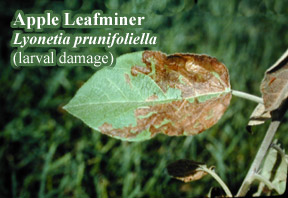 Apple leafminer, Lyonetia prunifoliella.
Apple leafminer, Lyonetia prunifoliella.
These leafminers injure terminal shoots by eating new leaves. Large populations can reduce the growth of young trees. In April or early May, the females that have overwintered begin to lay eggs singly in the undersides of the newest leaves. Caterpillars form linear mines at first, and then they expand them into blotches as they consume all of the leaf tissue between the upper and lower epidermis. When the caterpillars finish their feeding, they form pupae in silken hammocks suspended from the underside of leaves. Apple leafminers may have up to 6 generations per year, but the exact number depends on the temperature and the availability of new leaves. Typically, the damage is most severe in August and September when leafminers reach their peak abundance. Control usually is not necessary.
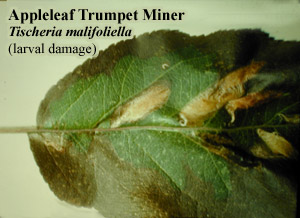 Apple leaf trumpet miner, Tischeria malifoliella.
Apple leaf trumpet miner, Tischeria malifoliella.
These leafminers can cause early leaf abscission, undersized fruit, and loss of tree vigor. Trumpet miners spend the winter as solitary caterpillars in mines of fallen leaves. In spring, the green caterpillars form pupae in the mines, and the tiny gray adult moths emerge in May to start a new generation. The caterpillars tunnel between the upper and lower leaf surfaces while they slowly enlarge their mines, which resemble tiny golden cornucopia. Moths emerge after pupae poke their heads through the upper surface of the mine. This miner has several generations per year, but large infestations have not been observed in the past 20 years. Chemical control is unnecessary because parasitic wasps and predators kill many of the developing caterpillars.
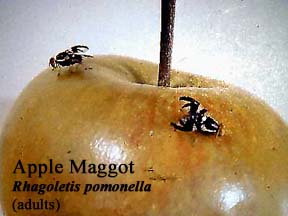 Apple maggot, Rhagoletis pomonella.The apple maggot is one of the three most destructive apple insects in New England. Larvae or "railroad worms" tunnel through developing apples, often destroying them. Flies spend the winter as pupae within seed-like puparia in the soil. The adults typically emerge between late June and August. They are about the size of a housefly and have black-and-white striped abdomens and black bars on their wings. About 7-10 days after emergence, females begin to lay eggs in fruit. Egg laying usually reaches a peak early in late July or early August, but it may continue until the apples are harvested. After hatching, the small legless maggots tunnel through the flesh of the apple. Upon completing development, the larvae leave the fruit to form their puparia in the soil beneath trees. The presence of adults can be detected with baited yellow sticky traps and with red sticky balls hung in the trees. The sticky traps are especially useful for detecting flies that migrate into orchards to start new infestations. Repeated applications of carbaryl and phosmet, which are among the compounds registered for use against this pest in Connecticut, control adults. Carbaryl used in the 30-day period after petal fall may thin the fruit. Rotenone, a botanical insecticide, combined with a synergist is an alternative, but less effective, spray to control adult flies. Consult the labels for dosage rates and safety precautions.
Apple maggot, Rhagoletis pomonella.The apple maggot is one of the three most destructive apple insects in New England. Larvae or "railroad worms" tunnel through developing apples, often destroying them. Flies spend the winter as pupae within seed-like puparia in the soil. The adults typically emerge between late June and August. They are about the size of a housefly and have black-and-white striped abdomens and black bars on their wings. About 7-10 days after emergence, females begin to lay eggs in fruit. Egg laying usually reaches a peak early in late July or early August, but it may continue until the apples are harvested. After hatching, the small legless maggots tunnel through the flesh of the apple. Upon completing development, the larvae leave the fruit to form their puparia in the soil beneath trees. The presence of adults can be detected with baited yellow sticky traps and with red sticky balls hung in the trees. The sticky traps are especially useful for detecting flies that migrate into orchards to start new infestations. Repeated applications of carbaryl and phosmet, which are among the compounds registered for use against this pest in Connecticut, control adults. Carbaryl used in the 30-day period after petal fall may thin the fruit. Rotenone, a botanical insecticide, combined with a synergist is an alternative, but less effective, spray to control adult flies. Consult the labels for dosage rates and safety precautions.
Apple red bug, Lygidea mendax.
This minor pest distorts the leaves on terminal shoots. Feeding on fruit produces a dimple or a series of small russet scars. Apple redbugs spend the winter as eggs. The nymphs hatch before apple bloom and usually mature in June. The adults are about 1/4" long, with bright red markings on the margins of the wings. Females insert their eggs into the bark lenticels of small twigs. These eggs remain dormant until the following spring. Dormant sprays of horticultural oil may kill the eggs. Malathion, which is among the compounds registered for use against this pest in Connecticut, applied at the end of bloom also effectively controls this minor pest. Consult the labels for dosage rates and safety precautions.
Buffalo treehopper, Stictocephala bisonia.
Buffalo treehoppers injure apple twigs when they lay eggs. If infestations are large, young trees may be stunted. In spring, nymphs hatch from eggs laid the previous year. They drop to the ground to feed on herbaceous plants, such as alfalfa and bindweed. The adults appear by mid-July and are green with a heavy spine on each shoulder. The females cut slits in twigs to lay their eggs. Sometimes the twigs die beyond the point of egg-laying. Reducing the amount of alfalfa and bindweed in orchards can decrease injury. An application of methoxychlor, which is among the compounds registered for control of this pest in Connecticut, may reduce populations of treehoppers. Methoxychlor, however, is toxic to parasites and predators. Consult the labels for dosage rates and safety precautions.
Cankerworms, Alsophila pometaria and Paleacrita vernata.
The measuring-worms or inch-worms of these moths eat apple foliage during the spring. When the caterpillars are abundant, they may defoliate the trees. In early spring, caterpillars hatch from the eggs laid on the trees in late fall or early spring. Older caterpillars are black or greenish with stripes. The male moths are gray with a wingspread of 1"; the female moths are wingless. Each species has only one generation a year. The abundance of cankerworms varies in cycles. The caterpillars can be controlled with one or more springtime applications of phosmet or azadirachtin, which are among the compounds registered for control of this pest in Connecticut. Consult the labels for dosage rates and safety precautions.
Casebearers, Coleophora spp.
The cigar casebearer and the pistol casebearer, which currently are being studied taxonomically, feed on apple leaves while they live in small silken cocoons attached to the surface of leaves. The common names refer to the shape of the cases. The areas where the caterpillars have fed are transparent at first, but later they become holes when the dead tissue drops out. The adults are small and relatively inconspicuous moths. Control usually is not necessary.
Clover mite, Bryobia praetiosa.
As the name indicates, nymphs and adults of this mite usually develop on clover or sometimes grass underneath the trees. The mites may migrate to apple foliage to feed. Feeding damage consists of leaf stippling, premature yellowing of the foliage, or early loss of leaves. These minute mites are flat-topped, with small scales around the margins of the body. Females lay the dark red, spherical eggs on twigs or under bark scales near the ground. There are several generations a year, but apple infestations usually appear in the spring or the fall. Chemical control usually is not necessary.
Codling moth, Cydia pomonella.
This moth is one of the three most destructive apple insects that feed directly on apples. Pinkish caterpillars that have overwintered under bark or debris form pupae in spring. Females emerge around bloom to lay eggs on fruit. The grayish adults are slightly more than 1/4" long, with wavy lines and a dark band at the tips of the wings. Caterpillars of the first of the two generations enter the fruit shortly after the blossoms fall. Those of the second generation injure fruit in August and September. The amount of damage varies greatly from year to year. Caterpillars of the codling moth are distinguished from those of other boring caterpillars by having a dark brown anal comb at the rear of the body and by tunneling directly to the core of the apple. Pheromone traps may be used to monitor adult flights. Applications of carbaryl, phosmet, or ryania, which are among the compounds registered for use against this pest in Connecticut, about 21 days after full bloom control the caterpillars. Consult the labels for dosage rates and safety precautions. Carbaryl, however, can cause thinning of fruit when it is used within 30 days after the petals fall.
Comstock mealybug, Pseudococcus comstocki.
Heavy infestations of mealybugs reduce the vigor of trees. In late May or early June, the nymphs hatch from the eggs that have overwintered and suck sap from apple trees. Nymphs mature in 4-6 weeks, and then the adult females lay eggs. Mealybugs have a flat pinkish body covered with a woolly secretion and a pair of long waxy tail filaments. The summer generation matures in September or October, and the adults lay the eggs that will hatch in the spring. These insects usually are not abundant enough to require control.
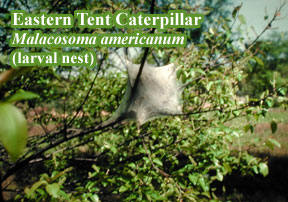 Eastern tent caterpillar, Malacosoma americanum.
Eastern tent caterpillar, Malacosoma americanum.
The damage of these caterpillars varies from almost none to complete defoliation of trees. In early spring, caterpillars hatch from the eggs that have overwintered. The hairy caterpillars build silken tents in which they hide except when they are feeding on leaves. By late June, the caterpillars mature, and soon the medium-sized moths are on the wing. Females lay eggs in masses attached to twigs. Eastern tent caterpillars have definite cycles of abundance, with a severe outbreak every 7 or 8 years. Foliar sprays of carbaryl, phosmet, or azadirachtin, which are among the compounds registered for use against this pest in Connecticut, effectively control caterpillars. Consult the labels for dosage rates and safety precautions. Carbaryl, however, should not be used before or during bloom because it is highly toxic to honey bees. In the 30-day period after bloom, carbaryl may cause thinning of fruit.
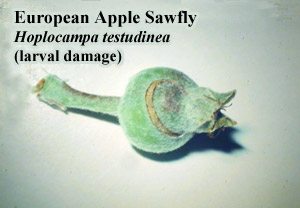 European apple sawfly, Hoplocampa testudinea.
European apple sawfly, Hoplocampa testudinea.
The larvae of the European apple sawfly damage the fruit. Mature larvae overwinter in the soil and form pupae in spring. The adult sawflies, which have clear wings and are slightly larger than a housefly, emerge as the apple trees begin to bloom. Females lay eggs in the flesh of the calyx cup. The larvae feed in the fruit just below the skin at the calyx end until they are about one-third grown. Afterward, they bore directly through the fruit, sometimes passing from one small apple to another. They usually leave chocolate-colored "sawdust" or feces on the apple surface. The numerous transverse lines on the body and the general shape of the head and body readily distinguish these larvae. White sticky traps placed in trees between pink and petal fall can help to determine the need for control of sawflies. Usually, an application of phosmet, which is among the compounds registered for use against this pest in Connecticut, at petal fall will control larval sawflies. Rotenone, a botanical insecticide, offers a lesser degree of control. Consult the labels for dosage rates and safety precautions.
European red mite, Panonychus ulmi.
Large infestations of these mites may cause bronzing of foliage and premature leaf drop. Apples on bronzed trees may be small. The mites spend the winter as red eggs on the bark of trees. Nymphs hatch from eggs about the time the shoots reach the tight cluster growth stage and develop rapidly. Mites have several generations each summer, with the peak abundance in July or early August. Mite eggs are best seen with a magnifier because they are extremely small. They are slightly flattened and have a delicate central hair. The adult females are dark red with white spots. Other stages vary from red to green in color. Unlike the overwintering eggs, the summer ones are brown. One or more applications of horticultural oil, which is among the compounds registered for use against this pest in Connecticut, before bloom provides control by suffocating the eggs that have overwintered. To minimize the chances of foliar damage from oil, the application rates are reduced as the growing season progresses. Consult the label for dosage rates and additional safety precautions.
Eyespotted bud moth, Spilonota ocellana.
Bud moths do not cause serious foliar injury to apple trees unless their populations are very high. Boring by caterpillars can be destructive to young trees because it reduces growth and sometimes causes abnormal tree growth. The solitary caterpillars overwinter within hibernacula on branches of small diameter. In spring, the small caterpillars bore into buds and growing shoots, and sometimes they feed on the surface of developing fruits. They usually feed on the lower surfaces of the leaves while they occupy a tubular nest made by webbing together several leaves at the tip of a shoot. Damage becomes apparent in late spring to early summer. The nests usually contain black specks, which distinguish them from those of the redbanded leafroller. The adult moths, which are brownish gray with a white band across the wings, fly mainly in the first half of summer. One or more foliar sprays of phosmet, which is among the compounds registered for use against this pest in Connecticut, should prevent damage. Consult the label for dosage rates and safety precautions.
Fall webworm, Hyphantria cunea.
Webworms cause minor foliar damage on apple trees. Caterpillars build a loosely constructed tent on the ends of infested branches. Tents, which usually are most abundant in the northeastern part of the state, are visible in late summer. Summer foliar sprays, such as carbaryl or phosmet, which are among the compounds registered for control of this pest in Connecticut, control this minor pest. Consult the labels for dosage rates and safety precautions. See Pear for additional details of the life history.
Flatheaded appletree borer, Chrysobothris femorata.
Larvae of this beetle injure apple trees by feeding in tunnels beneath the bark of trees, usually curled in a U-shaped pattern. The sinuous tunnels show through the bark as sunken areas. Borers prefer trees in poor condition and occasionally girdle them. As the common name indicates, larvae of this borer have a distinctly flattened thorax. The adults are about 1/2" long and dark brown with a metallic luster. In June and July, female beetles lay eggs in cracks in the trunk especially on the sunny side of trees. Trunk sprays of carbaryl or methoxychlor, which are among the compounds registered for use against this pest in Connecticut, applied in June and July may reduce infestations. Consult the labels for dosage rates and safety precautions.
Fruittree leafroller, Archips argyrospilus.
These leafrollers injure foliage and sometimes fruit. The eggs that have overwintered on bark hatch just before bloom. The caterpillars, which are green with black heads, generally develop between late April and mid-June. They form pupae between the middle and the end of June. At the beginning of July, females usually start to lay eggs in compact masses that turn white by spring. Over the past 20-30 years, infestations of the fruittree leafroller have been uncommon in commercial apple orchards. Pheromone traps may be used to monitor the flight of adult males. Dormant oil sprays help to kill the eggs, and later foliar sprays of carbaryl or phosmet, which are among the compounds registered for use against this pest in Connecticut, control the young larvae. Consult the labels for dosage rates and safety precautions. Carbaryl, however, should not be used before bloom because it is highly toxic to bees. Within 30 days after petal fall, its use may cause thinning of fruit.
Green fruitworm, Lithophane antennata.
Green and other fruitworms eat foliage in spring, and in May and June, the older caterpillars may feed upon young apples when they are about the size of a pea or larger. The cutworm-like caterpillars are green with longitudinal white stripes. Fruitworms, which have one generation per year, can be controlled by phosmet, which is among the compounds registered for use against this pest in Connecticut, applied just before and after bloom. Consult the labels for dosage rates and safety precautions. The biocontrol agent, Bacillus thuringiensis, also controls caterpillars of most species of fruitworms.
Green pug, Chloroclystis rectangular.
This exotic moth first invaded Connecticut in 1997. Foliar damage in the form of shredded terminal leaves first appeared throughout Connecticut in 1998. Overwintered eggs hatch in early spring. The caterpillars feed on tender new leaves, usually staining the remaining foliage brown. The fully grown green caterpillars are about 1/2" long, with a red line down the center of their back. They form pupae between late April and mid-May. The adults usually emerge in the second half of May. The moths are gray with some green scales on their wings and have a wingspan of about 3/4". Insecticides that control other springtime caterpillars also should be effective against the green pug.
Gypsy moth, Lymantria dispa.
Apple is one of the preferred hosts of this serious forest pest. In outbreak years, the caterpillars can completely defoliate unsprayed apple trees. Eggs pass the winter as white to tan masses on the bark of trees, and the hairy caterpillars hatch early in the spring. The caterpillars, which are dark gray with red spots and prominent hairs, grow to a length of about 2". Adult moths appear in midsummer, and females lay eggs in masses covered by their abdominal hairs. The male moths are mostly brown, and the females are mostly white. Dispersing larvae may damage orchards surrounded by heavily infested woodlands. Young caterpillars can be controlled with foliar applications of Bacillus thuringiensis, a biological control agent, or phosmet, which is among the compounds registered for use against this pest in Connecticut. Consult the labels for dosage rates and safety precautions.
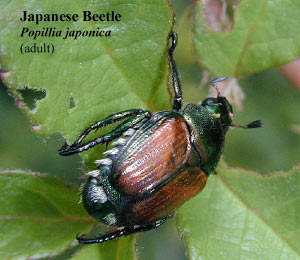 Japanese beetle, Popillia japonica.
Japanese beetle, Popillia japonica.
Adult beetles eat apple leaves in summer and can be especially damaging to young trees. The beetle is about half an inch in length, bright, shining green, with wing covers of a copper color. Two white spots on the tip of the abdomen show beyond the ends of the wing covers, and there are five white spots formed by patches of white hairs on each side of the abdomen. The beetle emergence begins the latter part of June; their greatest abundance is usually about the middle of July, but in certain seasons, particularly after drought periods, they may disappear altogether. The eggs are laid in July in the soil, and the grubs feed on grass roots near the surface, going downward to a depth of about a foot to overwinter. Late in April, they return to the surface, feed for a time, then enter the prepupal stage, and pupate in late May or early June. From 2 to 4 weeks later, the adults emerge. There is one generation each year. Feeding on the foliage can be prevented by using sprays of azadirachtin, carbaryl or malathion, which are among the products registered for use against this pest in Connecticut. Consult the label for dosage rates, safety precautions, and preharvest intervals. Treatment of lawn areas should reduce the numbers of beetles. See Lawns.
Leaf crumpler, Acrobasis indigenella.
Caterpillars of this moth live in black, twisted, horn-like tubes, while they feed first on the twigs and later on the developing leaves. Injury to young trees rarely is severe. The caterpillars mature in May, and the small moths with brown and white markings emerge 2 weeks later. In Connecticut, control is not necessary.
Leopard moth, Zeuzera pyrina.
The caterpillars of the leopard moth bore through the larger branches of the trees, causing limbs to break. The caterpillars overwinter in the wood of apple trees. The adult moths, which have white wings with black markings, lay eggs in July and early August. After hatching, the whitish or pinkish caterpillars bore into the bark and then into the wood. The leopard moth requires 2-3 years to develop. Removal of infested branches usually controls this occasional pest. With the trend toward dwarf and semidwarf trees, this handsome moth has become exceedingly scarce in orchards in Connecticut.
Lesser appleworm, Grapholita prunivora.
Appleworms damage trees by boring into shoots and by feeding on fruit. Full-grown caterpillars in cocoons overwinter on trees or in the litter. The caterpillars usually form pupae in late April or May, and the small dark grayish adults begin to appear in early to mid-May. Females lay eggs on upper leaf surfaces or fruit. The small pinkish caterpillars bore into fruit, typically at the calyx end. They feed just beneath the skin of the apple, causing rotted brown spots by harvest time. They also damage trees by boring into succulent terminal growth. Caterpillars mature by July, and they form pupae in silken cocoons on the bark or fruit. Adults of the first generation emerge in late July or August. Caterpillars of the second and final generation infest apples from August to early October. Pheromone traps can be used to monitor the adult flights. Sprays of carbaryl, phosmet, or ryania, which are among the compounds registered for control of this pest in Connecticut, reduce infestations by the lesser appleworm. Consult the labels for dosage rates and safety precautions. Carbaryl, however, can cause thinning of apples when it is used within 30 days after petal fall.
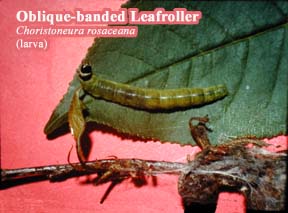 Obliquebanded leafroller, Choristoneura rosaceana.
Obliquebanded leafroller, Choristoneura rosaceana.
Caterpillars of this moth damage foliage and fruit. The foliar injury usually is unimportant, but the fruit damage, usually in the form of scarring, can be significant. Caterpillars that have overwintered begin to feed on leaf buds and fruit when the trees reach the tight cluster stage of growth in spring. They usually form pupae after petal fall, and adult moths fly in June. The females lay greenish yellow masses of eggs on the upper surfaces of leaves. After hatching, the caterpillars eat the young leaves on terminal shoots and sometimes apples. Adults of the summer generation fly in late July to August. Pheromone traps help to pinpoint the adult flight periods. Caterpillars of the second generation also feed on leaves and apples before they seek their overwintering sites. Foliar applications of Bacillus thuringiensis or phosmet, which is among the compounds registered for use against this pest in Connecticut, control caterpillars. Consult the labels for dosage rates and safety precautions.
Oriental fruit moth , Grapholita molesta.
Although oriental fruit moths primarily attack peach, they occasionally also bore into terminal shoots and fruit of apple. Mature caterpillars overwinter in impervious silk cases on the bark of the trunk or upon debris in orchards. These caterpillars are pink and about 1/2" in length. In spring, they form pupae in the cases, and the mostly gray adults emerge in late April or early May. The moths have a wingspan of just less than 1/2". Females typically lay eggs on leaves of the terminal growth. Caterpillars of the first generation bore into the terminal shoots, and they complete their feeding by June. Caterpillars of later generations bore into fruit. Caterpillars of the fruit moth do not tunnel to the core, which distinguishes them from the codling moth. The oriental fruit moth has 3 generations a year. The adult flights can be monitored with pheromone traps. Chemical control usually is not needed.
Oystershell scale, Lepidosaphes ulmi.
Heavy infestations of the oystershell scale reduce tree vigor because the scales suck water and nutrients from the tree. These insects sometimes kill limbs or entire trees. Scales also may develop on fruit, which lowers its value. Eggs overwinter under their mother scale on the bark of trees. Crawlers hatch in late spring and settle on the bark, usually 2-3 weeks after bloom. They insert their mouthparts and then form a waxy coating over their bodies. As they grow, they assume an oystershell-like shape, becoming elongate with one end enlarged. The gray scales mature late in the summer, and at that time, the females lay eggs under their waxy covers. Applying phosmet or diazinon may kill crawlers. To determine when crawlers are active, wrap black tape around infested limbs and coat the tape with Vaseline. The light-colored crawlers are easily seen on the tape.
Palmerworm, Dichomeris ligulella.
Palmerworms skeletonize apple leaves and sometimes injure young apples. The moths, which emerge from pupae in July, overwinter. In spring, caterpillars hatch from eggs and grow to a length of about 1/2". They are olive green, with two lateral and two dorsal white stripes. The abundance of the palmerworm varies greatly from year to year, but usually the small amount of damage does not warrant an insecticidal application.
Periodical cicada, Magicicada septendecim.
Adult females of the periodical cicada injure small branches, which may later break, when they lay eggs in them. Also, nymphal feeding by cicadas can reduce tree vigor. In Connecticut, the adults of the periodical cicada emerge every 17 years; the next emergence will be in 2013. The adults emerge during the evening in late May and early June. They are 1 1/2" long, with black bodies that have reddish orange markings. Their membranous wings have reddish orange veins. Groups of males sing to attract mates. After mating, the females lay batches of eggs in small branches by cutting slits with their saw-like ovipositors. The nymphs usually hatch in August and burrow into the ground where they develop slowly over the next 17 years while they suck the xylem fluid from tree roots. Adults may be controlled with applications of carbaryl or phosmet, which are among the compounds registered for use against this pest in Connecticut. Consult the labels for dosage rates and safety precautions. Carbaryl, however, may cause thinning of fruit when it is applied within 30 days after petal fall.
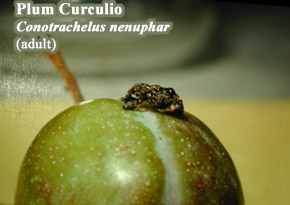 Plum curculio , Conotrachelus nenuphar.
Plum curculio , Conotrachelus nenuphar.
The plum curculio is one of the three most destructive pests of apple fruit. The adults scar the fruit when they lay eggs, and the larvae bore through the young apples, often causing them to drop from the tree. Adult curculios overwinter in debris in orchards and nearby forests. The adults are dark brown snout beetles that are about 1/4" long. They have distinctive humps on the wing covers. In spring, they become active about the time that the trees blossom. Females feed on blossoms and young fruit. They start to lay eggs soon after the petals fall and may continue this activity for 2 months. They insert eggs in crescent-shaped areas on the skin where they have fed. The grub-like larvae feed in the apple, often causing it to fall to the ground. The larvae enter the soil to form their pupae. After the adults emerge, they may feed on apples. Soon they seek sheltered areas in which to spend the winter. Plum curculios can be controlled by applying phosmet, which is among the compounds registered for use against this pest in Connecticut, at petal fall and again about 10 days later. Consult the labels for dosage rates and safety precautions.
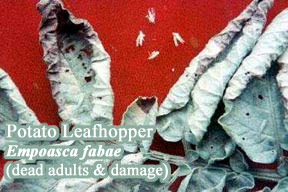 Potato leafhopper, Empoasca fabae.
Potato leafhopper, Empoasca fabae.
These leafhoppers can cause reduced growth of terminal shoots and excessive branching. These small pale green leafhoppers migrate to Connecticut from along the Gulf of Mexico, arriving in orchards by June. Both nymphs and adults feed by sucking fluids from leaves after they puncture the leaf tissue. The nymphs can be distinguished from those of other leafhoppers on apple because they move sideways when they are disturbed. These insects usually do not require control in home orchards. Applications of azadirachtin, ryania, or carbaryl, which are among the compounds registered for use against this pest in Connecticut, can control leafhoppers. Consult the labels for dosage rates and safety precautions. Carbaryl, however, can cause fruit thinning when it is used within 30 days after bloom.
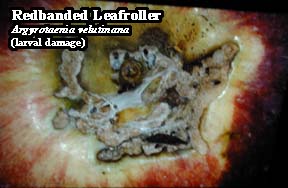 Redbanded leafroller, Argyrotaenia velutinana.
Redbanded leafroller, Argyrotaenia velutinana.
These leafrollers injure the foliage and the fruit of apple trees. The foliar injury is usually unimportant, but the fruit damage, usually in the form of scarring, can be significant. Pupae of the red-banded leafroller overwinter in sheltered areas. The moths, which are 1/2" long and have a red band across the wings, emerge in April. Females lay masses of eggs on the bark, and the caterpillars hatch at about the end of bloom. The green caterpillars feed along the midvein or larger veins while they live in a flimsy white web that expands as the larvae grow. Caterpillars mature during June and form pupae in sheltered locations, such as folded leaves. The red-banded leafroller has 3 generations per year. Females lay the eggs of the second and third generations mainly on the upper surfaces of leaves. Caterpillars of these generations feed on the lower surfaces of leaves and sometimes on fruit when it touches leaves. Adult flights of the red-banded leafroller can be monitored with pheromone traps. Phosmet or the biocontrol agent, Bacillus thuringiensis, which are among the compounds registered for use against this pest in Connecticut, applied immediately before and after bloom can provide season-long control. Consult the labels for dosage rates and safety precautions.
Resplendent shield bearer, Coptodisca splendoriferella.
Caterpillars of this leafminer may cause minor foliar injury on apple. See Quince.
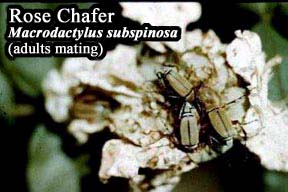 Rose chafer, Macrodactylus subspinosus.
Rose chafer, Macrodactylus subspinosus.
Adults of the rose chafer are foliar pests of peaches, roses, grapes, and sometimes apples. When very abundant, this insect injures roses and many other shrubs and trees by the beetles skeletonizing the leaves. They also cause injury to the flowers, particularly white flowers, by feeding upon the petals and soiling them with excrement. Rose chafers breed most abundantly in sandy waste land but sometimes occur in lawns; they appear each year about June 10 to 12, and feed for about a month, though some of the beetles are present for 6 weeks. The females each lay from 24 to 36 eggs singly in the ground a few inches beneath the surface. They soon hatch and the young grubs feed upon the roots of grass and other plants, becoming full grown by late autumn when they go into the ground several inches to overwinter. The next April or May, they come near the surface and transform to pupae in earthen cells, and from 2 to 4 weeks later the beetles emerge. The adult beetle is yellowish grayish brown or clay colored and is a little over 1/3" (10-12 mm) long, with long sprawling legs. The larva is a white grub about 3/4" long when full grown. For control, see Japanese beetle above.
Rosy apple aphid, Dysaphis plantaginea.
These pink aphids cause curled leaves and deformed fruit. The shiny black eggs that have overwintered on apple trees hatch at about the half-inch green growth stage of apple, which usually occurs in late April. The nymphs suck the fluids from the developing fruit and leaf buds. Often sooty mold grows on the honeydew that they excrete. The adults are pinkish gray with a powdery white coating. These aphids feed on apple foliage and fruit for 3 generations. They have an enormous capacity to reproduce. In late June or early July, the winged adults migrate to narrow-leaved plantain, their summer host. In the fall, the adults return to apples, and the females lay their eggs on twigs. Damage may be reduced by applying horticultural oil, which is among the compounds registered for use against this pest in Connecticut, while the trees are dormant. Consult the labels for dosage rates and safety precautions.
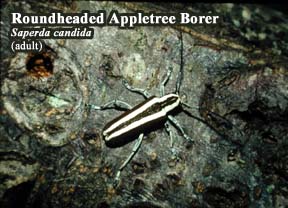 Roundheaded appletree borer, Saperda candida.
Roundheaded appletree borer, Saperda candida.
Larvae of the roundheaded appletree borer tunnel deeply into the trunks of the trees from 4" below ground to 1-2' above ground. Borers mainly injure young trees, weakening or girdling them. Adults lay eggs from June to August. The adults are slender long-horned beetles that are about 3/4" long and brown with two conspicuous longitudinal white stripes on the wing covers. The larvae may take up to 3 years to develop to maturity. Normal sprays for the plum curculio and apple maggot usually control borers because the adults ingest the insecticides as they eat leaves.
San Jose scale , Quadraspidiotus perniciosus.
Large infestations of the San Jose scale can cause branch and even tree death as well as red spots on fruit. Partially grown scales overwinter under their circular gray covering or scale on the twigs and the branches of trees. They begin to feed as the sap starts to flow. When apple trees bloom, the males emerge from under their scales to mate with the immobile females. Females are circular and cone-shaped, and their circular scales are about 1/16" in diameter, with a raised center or nipple. The males are smaller and elongate, with the nipple not centered on the scale. Females give live birth to tiny bright yellow crawlers in June, usually about 3-5 weeks after the flower petals drop. The young crawlers quickly settle, insert their long mouthparts into the twigs, and then suck sap from branches. As they grow, the crawlers secrete a waxy filament that becomes their scale or covering. Scales apparently have 2 generations per year, with the first in June and the second in August. To control scales, apply horticultural oil at the half-inch green growth stage or phosmet after bloom to kill the crawlers. Both materials are registered for use in Connecticut, but consult the labels for dosage rates, safety precautions and preharvest intervals. To detect the yellow crawlers, wrap black tape coated with Vaseline around small branches. Adult flights may be detected with pheromone traps.
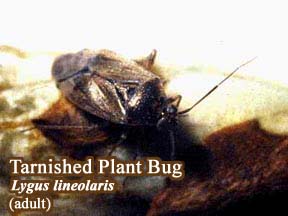 Tarnished plant bug, Lygus lineolaris.
Tarnished plant bug, Lygus lineolaris.
Plant bugs can cause flower abscission and fruit dimpling and scabbing. The tarnished plant bug is a mottled brownish bug about 1/5" long that hibernates in protected places. The eggs are inserted in the tender tissues of plant stems, leaves, and buds, and the young bugs or nymphs are yellowish green and pass through five nymphal stages before becoming adult. The adults are good fliers, and often move into other crops after feeding on hayfields or weeds. Overwintered adults become active as the weather warms in spring. They inflict injury when they feed between tight cluster and petal fall stage of apple growth. In early spring, the activity of the tarnished plant bug can be monitored by placing white sticky traps at knee height near the perimeter of trees. Because tarnished plant bugs have a broad host range, controlling broad-leaved weeds may reduce their overwintering populations. Avoid herbicide applications or mowing from just before until 2 weeks after bloom because the disturbance may drive the adults from their alternate hosts to the apple trees. An application of methoxychlor, which is among the compounds registered for use against this pest in Connecticut, before bloom may reduce injury. Consult the labels for dosage rates and safety precautions. A recently introduced parasitoid of the tarnished plant bug, Peristenus digoneutis, attacks the nymphs of the tarnished plant bug on alfalfa and may help to reduce populations moving into other crops.
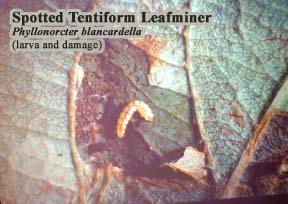 Tentiform leafminers, Phyllonorycter spp.
Tentiform leafminers, Phyllonorycter spp.
Severe infestations of the spotted tentiform leafminer, Phyllonorycter blancardella, and the apple blotch leafminer, P. crataegella, may cause early leaf drop, undersized fruit, and loss of tree vigor. Both species overwinter as pupae in mines in fallen leaves. Adults usually emerge between early April and early May, and the females lay solitary eggs on the undersides of leaves. The young caterpillars, which are flattened, live in blotches on the undersides of leaves as they lacerate leaf tissue with their sickle-like mandibles to drink sap. After they molt into cylindrical caterpillars with chewing mouthparts, they eat holes into the roof of their mines, giving the mines a spotted appearance when they are viewed from the top of the leaf. Also, the mines become tent-like, thus the common name. By contrast, caterpillars of the unspotted tentiform leafminer, Parornix geminatella, eat the entire upper surface of their mines. The caterpillars of tentiform leafminers form pupae within their mines, and the adults emerge after the pupae poke their heads through the lower surface of the foliar mine. These leafminers may have 3 generations per year, with the abundance generally increasing from spring to fall. Adult abundance can be monitored with unbaited yellow or red sticky traps placed on the trunks or hung on the limbs. Pheromone traps are available for the spotted tentiform leafminer, the more common of the two tentiform leafminers. Chemical control is not necessary in home orchards because parasitic wasps and various predators kill a large proportion of the caterpillars.
Twospotted spider mite, Tetranychus urticae.
Foliar damage caused by the twospotted mite is similar to that caused by the European red mite. Mature females spend the winter on the lower portion of tree trunks or in the ground cover. The twospotted spider mites feed first on cover crops, and move up the tree as the season progresses. As the common name indicates, the summer adults have a dark spot on each side of the body. Twospotted mites can develop through many generations, depending on the temperature. Their abundance usually peaks in August. Many beneficial insects and mites feed on twospotted mites. In home orchards, control usually is not necessary.
White apple leafhopper, Typhlocyba pomaria.
Feeding by large populations of the white apple leafhopper causes leaves to appear spotted. This foliar injury indirectly may affect bud formation and lead to poor fruit color or early apple drop. Eggs overwinter on the bark of wood that has an age of 1-5 years. Nymphs typically hatch in the period just before bloom until petal fall. The pale white to greenish yellow nymphs feed on the undersides of older leaves, removing chlorophyll to leave the spotted or white foliage. Adults, which feed on leaves and sometimes developing apples, are white and about 1/8" long. A second generation develops from August to October. Sprays of carbaryl usually control the white apple and other leafhoppers although fruit thinning may occur when applications are made within 30 days after bloom. Alternative controls include azadirachtin, ryania, and pyrethrins, which are among the compounds registered for use against this pest in Connecticut, plus a synergist. Consult the labels for dosage rates and safety precautions.
Woolly apple aphid, Eriosoma lanigerum.
These aphids cause knotty galls on the roots and twigs and reduce the vigor of trees. Woolly apple aphids have a complex life cycle during which they may use several hosts, but elm and apple are the principal hosts. In spring, nymphs hatch from the eggs that have overwintered on elm trees, and they begin to feed on the buds and leaves. The reddish brown to purple nymphs easily are identified because they secrete tufts of a white, cottony-like substance on their bodies. After 2-3 generations, winged females develop and migrate to apple or other rosaceous plants. On apple, the females start colonies that may complete several generations. Subterranean colonies of nymphs also can spend the winter on apple roots. These colonies develop through several generations on apple roots, finally producing winged females that move to the aerial parts of the tree to start new infestations in the cracks and the crevices on the bark or at the base of growing shoots. In autumn, the winged adults of both sexes migrate to elm where the females lay eggs that will overwinter. Infestations of the woolly apple aphid may be reduced during the summer by pruning branches with colonies. The removal of suckers at the base of trees and on the main scaffold limbs is especially important. An application of horticultural oil or diazinon, which are among the compounds registered for use against this pest in Connecticut, at the 1/2"-growth stage sometimes provides good control. Consult the labels for dosage rates and safety precautions. Non-oil insecticides, such as diazinon, are harmful to the parasitic wasp, Aphelinus mali, and other natural enemies that may reduce infestations of the woolly apple aphid.
Google How to Get Black Spots Off of Apples
Source: https://portal.ct.gov/CAES/Plant-Pest-Handbook/pphA/Apple-Malus